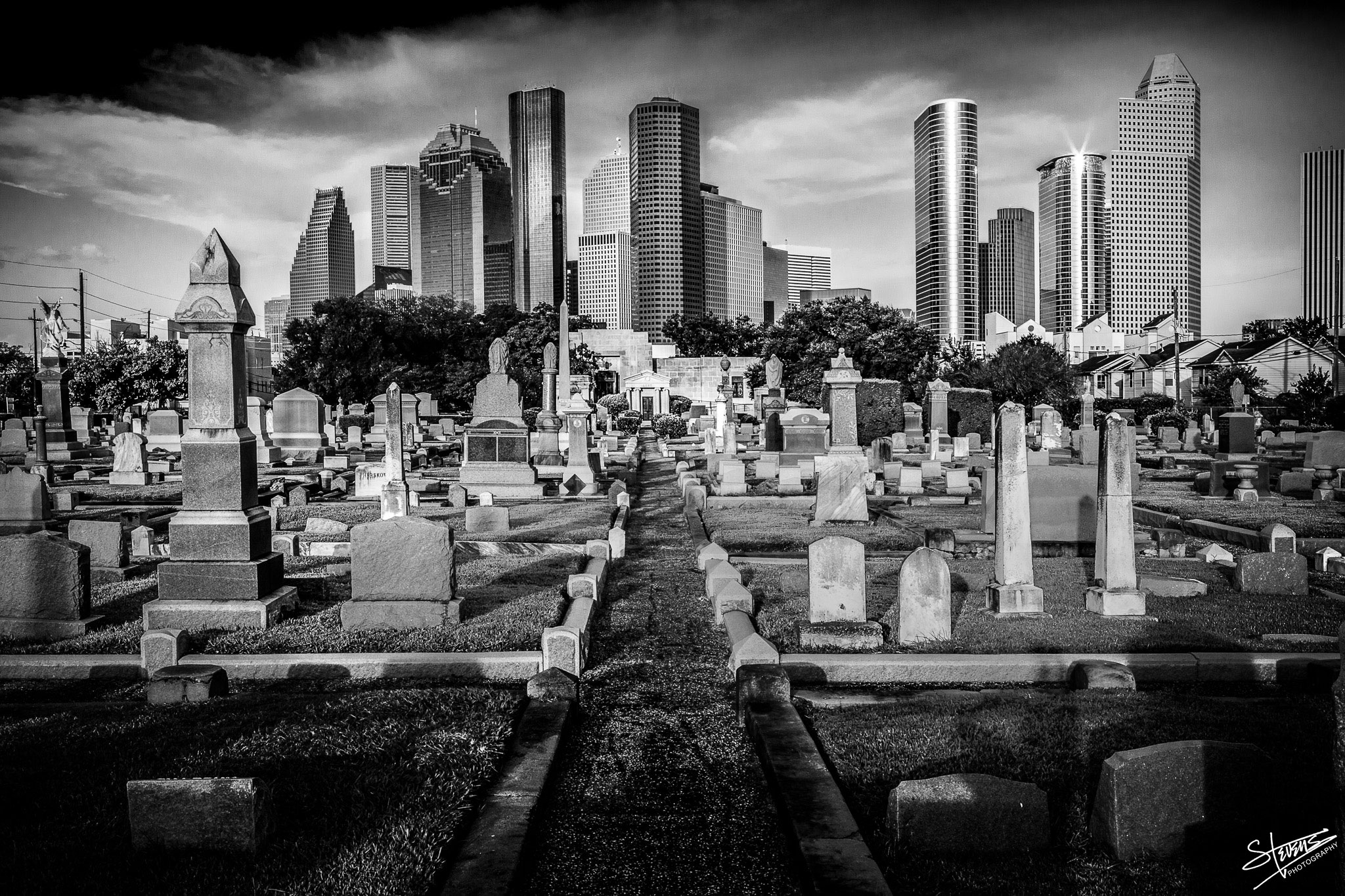Cities of Stone, Cities of Glass
Beth Israel Cemetery, Houston — 2014

I was on my way out of Houston, GPS barking left-right- reroute, when a guy on a street corner suggested a “pretty cool old cemetery” with a skyline view. One last photo before the highway? Why not. The address put me in a lopsided neighborhood of chain-link and cracked sidewalks. All I saw at first was an eight-foot fence and a tight grid of headstones inside it. Then I spotted the angle: a straight gravel aisle leading through weather-worn markers to a wall of downtown skyscrapers glowing in late-day sun. It looked like a postcard from the afterlife: Wish you were here — eventually.
. . . Decide what small, steady thing you’ll hand to whoever comes next. It doesn’t have to be epic. A good recipe, a worn guitar riff — these are the bricks future skylines rest on.
The fence wasn’t part of that postcard, so I did the slightly dumb thing. Boots in wire diamonds, camera around my neck, I climbed until my eyes cleared the top rail. One hand gripped metal; the other fired a burst of frames. Old stones up front, mirrored towers in back — past and present stacked like layers on a slide projector. Five clicks later gravity whistled me down, and I hopped off, shoes crunching gravel among names of people who once believed themselves equally permanent.
Weeks later, at my desk, the photo popped open on the big screen and the message smacked me between the eyes: No matter how high we build, every story checks out here. Those towers we chase with deadlines and overtime? Temporary applause. The finale is carved in granite at our feet.
That could feel bleak, but the picture wouldn’t let me mope. Spend a minute with it and a quieter idea surfaces: The people buried here once built the view we admire now. Their paychecks poured the concrete. Their blueprints sketched the towers. Their dreams became our city. The graveyard isn’t a finish line; it’s a relay hand-off where one generation passes the baton to the next.
That thought changed my calendar. If we’re all running the same relay, maybe the point isn’t to sprint the whole lap. Maybe it’s to carry the baton carefully, add a little shine, and pass it forward. I started asking different questions: Have I said the kind word that outlives me? Fixed something someone else might use? Left behind more than laundry and browser tabs?
Look back at the photo. The markers aren’t a timid row of tablets; they rise in every shape a life can take — plain slabs like starter homes, blocky vaults like office boxes, and a few marble obelisks that throw their own rough-hewn spires against the sky. They echo the city they helped build: some modest, some grand, all claiming a little vertical space before settling in for good. Meanwhile the downtown towers fetch every sunset color like magpies — beautiful, sure, but glass cracks and steel gets replaced when tastes change. Those stone monuments suggest that stature isn’t about height; it’s about how long the engraving lasts after the builders have moved on.
The gravel path down the middle seals the deal. It’s just wide enough for one or two people to walk, bordered by curbs that have stayed true for decades. Pick a direction, keep your footing, don’t worry if the route seems small. Small routes, walked often, carve real lines on a map.
For years I didn’t even know the cemetery’s name. Then a friend and I went sleuthing — timestamp, sun angle, Google Earth — and finally pinned it down: Beth Israel Cemetery, the oldest Jewish burial ground in Texas. Funny how the place that handed me such a big reminder stayed nameless until a bit of teamwork filled the blank.
Now the print hangs above my desk. On frantic mornings it nudges: Deadlines, yes, but also daylight — use both. On tired nights it mutters: Even a quick thank-you call builds something a spreadsheet can’t.
If the weight of time ever presses on your shoulders, picture yourself at that fence line. Feel the hush of the headstones behind you. See the glass towers reflecting whatever light you aim at them. Then decide what small, steady thing you’ll hand to whoever comes next. It doesn’t have to be epic. A good recipe, a worn guitar riff, honest work done well — these are the bricks future skylines rest on.
I left Houston with dust on my boots and a memory card half full. The city sent me off with a simple assignment: Build something that matters for longer than you’re around. Not by erecting monuments, but by stacking everyday choices until they look, from a distance, like purpose. And if I can take that commission on an impulsive roadside detour — later confirmed by a friend’s bit of detective work — maybe anyone can. No climbing required, just a clear look at where we stand and what rises beyond.
In your community, what old structure and new building tell a shared story?
— Lawrence

Thanks for reading Still Stories! Subscribe for free to receive new posts and support my work.

